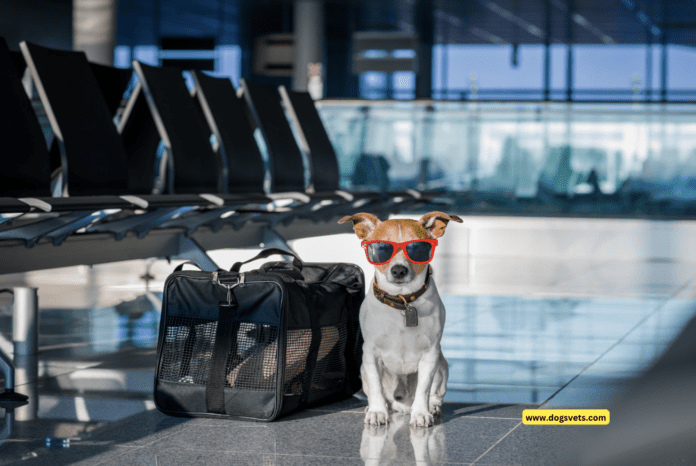Last Updated on January 14, 2024 by Dogs Vets
Airlines That Allow Dogs in Cargo
Traveling with your furry friend is a great way to experience new places together.
However, not all airlines allow dogs in the cabin, so if you’re planning on flying with your pup, it’s important to choose an airline that is pet-friendly.
In this blog post, we’ll take a look at the airlines that allow dogs in cargo, as well as the requirements and fees associated with flying your dog in cargo.
Airlines That Allow Dogs in Cargo
The following airlines allow dogs in cargo:
- Aegean Air
- Air Canada
- Air Europa
- Air France
- Alaska Airlines
- American Airlines
- British Airways
- Delta Air Lines
- Hawaiian Airlines
- KLM Royal Dutch Airlines
- Lufthansa
- Singapore Airlines
- TAP Air Portugal
- TUI Fly
- United Airlines
- WestJet
Requirements for Flying Your Dog in Cargo
All airlines have different requirements for flying dogs in cargo, so it’s important to check with the specific airline you’re flying with before you book your flight.
Some general requirements include:
- Your dog must be at least 8 weeks old and have a health certificate from a veterinarian dated within 10 days of travel.
- Your dog must be up-to-date on all vaccinations.
- Your dog must be in a secure kennel that is large enough for it to stand up, turn around, and lie down comfortably.
Fees for Flying Your Dog in Cargo
The fees for flying your dog in cargo vary depending on the airline and the length of your flight. However, you can expect to pay between $100 and $500 for each leg of your journey.
10 Tips for Flying Your Dog in Cargo
It’s important to ensure your furry friend has a safe and comfortable journey, so here are 10 tips to help you out:
Planning & Preparation:
- Consult your veterinarian:
Before booking, get your dog a thorough check-up and ensure all vaccinations are up-to-date. Discuss any potential health concerns related to flying.
- Choose the right airline:
Research airlines’ pet policies and compare fees. Opt for reputable airlines with experience handling animals.
- Book a direct flight: Minimize stress with a non-stop journey. Avoid flights with layovers or extreme temperature changes.
- Get the proper crate: Use an IATA-approved, well-ventilated crate with enough space for your dog to stand, turn around, and lie down comfortably. Label it clearly with “Live Animal” and arrival information.
- Microchip identification: Consider microchipping your dog for added security and peace of mind.
Pre-departure & Comfort:
- Familiarize your dog with the crate:
Start crate training well in advance. Leave the crate open at home with comfy bedding and toys to encourage positive association.
- Exercise and potty break:
Take your dog for a thorough walk and bathroom break before check-in. An empty bladder and exercised body reduce stress and potential accidents.
- Pack familiar items: Include a favorite toy or blanket in the crate to provide comfort and familiar scent.Avoid placing food or water bowls inside, as they might spill during handling.
- Hydration and last meal: Offer water up until departure, but remove the bowl before check-in. Consult your vet about giving your dog a light meal 4-6 hours before the flight.
- Stay calm and confident: Your dog mirrors your emotions. Remain calm and reassuring throughout the process to transfer positive energy.
Extra Tips for Flying Your Dog in Cargo
Here are a few tips for flying your dog in cargo:
- Book your flight well in advance, especially if you’re traveling during peak season.
- Arrive at the airport early to allow enough time for your dog to be checked in and processed.
- Make sure your dog’s kennel is properly labeled with your contact information.
- Provide your dog with plenty of food and water before the flight.
- Ask the airline about their pet relief procedures.
Conclusion
Flying with your dog in cargo can be a safe and convenient way to travel together. However, it’s important to choose an airline that is pet-friendly and to follow the airline’s specific requirements.
Bonus tip: Check the latest weather conditions at your destination and choose a flight time accordingly. Avoid excessively hot or cold periods to ensure your dog’s comfort during ground handling.
Remember, flying in cargo can be stressful for dogs. Weigh the pros and cons carefully and explore alternative travel options if possible. Consider cabin travel as a less stressful option if your dog meets the size and weight requirements.
I hope these tips help you prepare for your dog’s smooth air travel journey!
By following the tips in this blog post, you can help to ensure a safe and comfortable flight for your furry friend.
FAQs
What are the risks of flying my dog in cargo?
A: The risks of flying your dog in cargo are generally low. However, there are some potential risks, such as:
- Extreme temperatures
- Noise and vibration
- Oxygen deprivation
- Injuries
How can I minimize the risks of flying my dog in cargo?
A: There are a few things you can do to minimize the risks of flying your dog in cargo:
- Choose an airline that has a good reputation for safely transporting pets.
- Book your flight during the cooler months of the year, if possible.
- Make sure your dog’s kennel is properly labeled with your contact information.
- Provide your dog with plenty of food and water before the flight.
- Ask the airline about their pet relief procedures.
What should I do if my dog is injured or sick after flying in cargo?
A: If your dog is injured or sick after flying in cargo, it’s important to seek medical attention immediately. You should also contact the airline to file a claim.
Can I fly my dog in cargo if it is a service animal?
A: Yes, you can fly your service animal in cargo. However, you must notify the airline in advance and provide documentation proving that your dog is a service animal.
What are some alternatives to flying my dog in cargo?
A: There are a few alternatives to flying your dog in cargo, such as:
- Flying your dog in the cabin.
- Hiring a pet shipping company.
- Driving with your dog.
What is the best way to choose an airline for flying my dog in cargo?
A: When choosing an airline for flying your dog in cargo, it’s important to consider the following factors:
- The airline’s pet policy
- The airline’s reputation for safely transporting pets
- The airline’s fees for flying pets
- The availability of flights to your destination

















